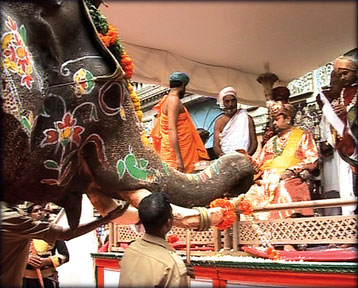Mysore Dasara, the acme of India pageantry
by Kalakeerthi Edwin Ariyadasa
“For those who believe,
no explanation is necessary. For those who do not, no explanation is
possible.
-Old
proverb
The orient is justly celebrated for its soul-elevating array of
breath – taking pageants. Our own ‘Resplendent Isle’ – Sri Lanka, is
globally renowned for its magnificently panoplied periodical pageants,
that stir the sense of wonder and amazement, of the spectators, moving
them towards a quiver of awe, tinged with adoration. Our
pachyderm-filled perahera in Kandy, occupies a high position, in the
pageants of global-scale.
|

A scene from the pageant |
But of all those oriental pageants of legendary and fabled majesty
and overwhelming glory, the undoubted acme, to my mind, is the ten-day
Dasara spectacle in Mysore.
Appeal
My forthright assertion may engender a trace of doubt within you.
Nevertheless, I cannot help but assure you, that you must witness the
Dasara pageant yourself, to believe it.
The compelling appeal of Mysore Dasara, is the outcome of a whole
series of highly significant adjuncts.
The core-origin of the pageant is an age-old myth of a divine
victory, over an evil scourge-symbolised by Mahishasura demon. Goddess
Chamundeshvari vanquished the ferocious demon.
The annual 10-day pageant Dasara celebrates this triumph and is part
of the cult of Goddess Chamundeshvari.
In consequence, this is a sacred myth, deeply embedded in the
folk-culture of the land.
In addition, the royal patronage extended to the pageant over the
centuries, has infused into it a regal splendour.
Over and above that, the pageant has a long history. In 2013, what
was performed, was the 403rd edition of the pageant.
This extensive tradition has given to the Dasara pageant a hallowed
sacred touch.
Crowning glory
But the crowning glory of it all is the fabulous, sprawling palace of
Sri Kantha Datha Narasimharaja Wodeyar, the incumbent Maha Raja of
Mysore. This palatial miracle forms the backdrop of the pageant.
All these elements cumulatively enrich the Dasara pageant, catering
astonishingly to the mass aesthetic.
I was part of the delegation to the Dasara pageant present on the
occasion of its 403rd edition, on the invitation of Swamiji Sunil Das of
the spiritual staff of the royal palace.
The leader of our delegation was Ven. Daranagama Kusaladhamma Nayake
Thera – head of the Buddhist TV channel.
I am grateful to the Nayaka Thera for the opportunity given to
witness the wonder described as Dasara.
Palace complex
The imposing palace complex which seems a glorious edifice, bodily
planted in the modern era from the glorious ages of India’s legendary
Maharajas, overwhelms you with its ornate super-luxury. We had the
privilege of visiting the palace premises, witnessing even certain
sections that are not generally open to many of the visitors.
Of the multiplicity of treasures held by the palace is the golden
throne, created with 80 kilograms of gold.
The royal events linked to the Dasara pageants included the special
Durban (royal court) at which the king blesses some royal officials.
Here the elephants, horses, camels, cows and vehicles are also
brought before the ruler who occupies a throne on a raised dais.
Climactic point
The elaborate pageant needs special recounting. The pageant reaches
its climactic point on the tenth day which is described as Vijayadashami
(the 10th Victorious Day). On that day the pageant moves along
majestically with the leading elephant bearing the effigy of Goddess
Chamundeshran. The image is created with 750 kgms of gold.
For 13 consecutive years, this sacred task of bearing the effigy of
the goddess had been performed by the 55 year-old elephant Balarama.
But, this year around, the responsibility was transferred to a
new-performer, the 53-year-old Arjuna. There is an element in this
elephant-story that will certainly intrigue Sri Lankans.These sacred
elephants are not only caparisoned – they are painted as well.
Painted elephants
The painting of elephants has been done by an art teacher named
Nagalingappa R. Badiyer for 11 years. He paints his jumbo clients for
hours. The legs, the ears, the tusks and even the tails are carefully
painted, utilising a whole series of motifs. While this painting job is
being done, massive elephants remain docile, without displaying even a
trace of impatience.
The heavy, sacred golden image is lowered into the back of the
elephant, with the help of a winch.
The elephant bearing the effigy moves along with an alluring poise.
During the Dasara nights, the main palace and the other palaces are
fully illuminated.
When the devotees view the palace and its surroundings from the hill
where the temple of the goddess is located, the whole region seems one
vast stretch of light.
Recitals of classical musical programs continue throughout the
pageant nights. A universal decorative item utilised during Dasara
season, in the young banana plant. Even vehicles are decked with these
plants.
State elephants
In the Mysore Dasara pageant, the elephant are given a high-profile
stature. Those elephants associated with the pageant are described as
Pattada Ane or state elephants.
An elephant that has been in the service of Dasara has been honoured
by naming a city-gate after him.
The picturesque pageant is celebrated as a national event. The whole
state observes an official holiday on the final day of the Dasara.
If Dasara is a unique ceremony, it is partly because of the
traditional royal patronage provided for this pageant.
We had the good fortune of gaining an audience with The Maharaja. In
the course of his conversation with us, he enquired about our country,
displaying an intimate awareness of Sri Lanka.
He said that he would visit Sri Lanka after his scheduled visit to
Mauritius in 2015. The impressions of the legendary Mysore Palace have
to be celebrated at some length. |

